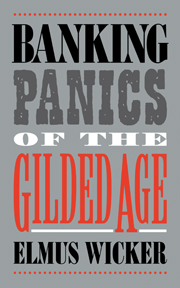Book contents
- Frontmatter
- Contents
- Preface
- 1 The Bank Panic Experience: An Overview
- 2 The Banking Panic of 1873
- 3 Two Incipient Banking Panics of 1884 and 1890: An Unheralded Success Story
- 4 The Banking Panic of 1893
- 5 The Trust Company Panic of 1907
- 6 Were Panics of the National Banking Era Preventable?
- 7 Epilogue
- Appendix
- References
- Index
3 - Two Incipient Banking Panics of 1884 and 1890: An Unheralded Success Story
Published online by Cambridge University Press: 21 October 2009
- Frontmatter
- Contents
- Preface
- 1 The Bank Panic Experience: An Overview
- 2 The Banking Panic of 1873
- 3 Two Incipient Banking Panics of 1884 and 1890: An Unheralded Success Story
- 4 The Banking Panic of 1893
- 5 The Trust Company Panic of 1907
- 6 Were Panics of the National Banking Era Preventable?
- 7 Epilogue
- Appendix
- References
- Index
Summary
The banking disturbances in 1884 and 1890 do not resemble the banking panics of 1873, 1893, and 1907 in at least four important aspects. The number of bank closings excluding brokerage houses (private banks) in both New York and the interior were few, probably not more than twenty in each episode. The prompt action by the NYCH in coming to the aid of the distressed banks by authorizing the issue of clearing house loan certificates was responsible for preventing the banking difficulties in New York from worsening and from spreading to the interior. In neither episode was there a general loss of depositor confidence either in New York or in the rest of the country. Failures for the most part were bank-specific, having as their cause, real or alleged, the misappropriation of funds or careless and imprudent management practices rather than a contagion of fear overtaking solvent and insolvent banks alike. Moreover, there was no suspension of cash payment.
The action of the NYCH was able to contain the banking disturbances in 1884 and 1890 in an incipient stage and thereby halt any escalation into a full-scale banking panic. A better understanding of what happened in these two periods may provide useful insight into why the banking panics of '73, '93, and 1907 were far more serious as measured by the number and incidence of bank closings, the amount of hoarding, and the effects on the rest of the country.
- Type
- Chapter
- Information
- Banking Panics of the Gilded Age , pp. 34 - 51Publisher: Cambridge University PressPrint publication year: 2000
- 1
- Cited by

